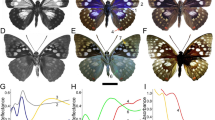Abstract
Wing scales of the mothEuchloron megaera L. (Sphingidae) contain a water-soluble green pigment showing pH indicator properties. This pigment has been isolated. The UV-visible spectra, the color changes, the reduction by dithionite, the polarity on SiO2 TLC, and the high molecular weight relate this pigment to an anthocyanidin derivative derived from the plant food. This result is discussed in connection with the presence of similar substances in plants of the family Apocynacea and in other moth species of the Sphingidae group, in which they play aposematic roles. As a hypothesis, it is suggested that the green pigment results from a reaction betweenNerium sp. anthocyanidins (plant food) and NH2 groups of basic constituents present in the animal.
Similar content being viewed by others
References
Barbier, M. 1981. The status of blue-green bile pigments of butterflies and their phototransformations.Experientia 37:1060–1062.
Bois-Choussy, M., andBarbier, M. 1983a. The action spectrum and phototransformations of pterobilin (biliverdin IXγ).Arch. Biochem. Biophys. 221:590–592.
Bois-Choussy, M., andBarbier, M. 1983b. Photo-oxidations and photoprotection in the IXγ bile pigment series. A comparison of the photoprotective roles of pterobilin, phorcabilin and sarpedobilin in vitro.Tetrahedron 39:1915–1918.
Bois-Choussy, M.,Veith, H.J., andBarbier, M. 1974. Unpublished results.
Harborne, J.B. 1967. Comparative Biochemistry of the Flavonoids. Academic Press, London.
Paris, R., andDuret, S. 1972a. Distribution and metabolism of flavonoids. Variations of flavonoids in Laurier-roseNerium oleander in the course of vegetation.Bull Soc. Bot. Fr. 119:531–542.
Paris, R., andDuret, S. 1972b. Chemotaxonomy of Apocynacae polyphenols. Flavonoids and phenolic acids from someEchitodidae, Baissen, Echitella, Nerium and Strophantus.Plant Med. Phytother. 6:210–215.
Ribéreau-Gayon, P. 1968. Les Composés phenoliques des végétaux. Dunod, Paris.
Sanyal, P.K., andDas, H.K. 1956. An acid-base indicator principle in the flowers of raktakarviNerium odorum.J. Proc. Inst. Chem. India 28(2)153–156;Chem. Abstr. 51:3354g.
Author information
Authors and Affiliations
Rights and permissions
About this article
Cite this article
Barbier, M. A substance which acts as a pH indicator from the mothEuchloron megaera L.. J Chem Ecol 10, 1109–1113 (1984). https://doi.org/10.1007/BF00987516
Received:
Revised:
Issue Date:
DOI: https://doi.org/10.1007/BF00987516




